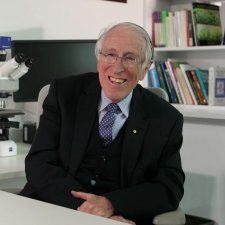- I started my journey as a, I suppose as a five-year old. My dad had a severe hearing loss and my primary school teacher said, when she asked the kids in her class what they wanted to do, I said to her that I wanted to fix ears 'cause I wanted to help someone like my dad. 'Cause I knew how difficult it was in the family and later on, when I was 10, the local minister asked me what I wanted to do and I said I wanted to be an ear, nose, and throat surgeon. It was a bit unusual. I think I had this desire to help deaf people but I also wanted to make discoveries about the brain.
The most important aspect, in a way, is that little object which is the prototype, multi-channel cochlear implant or bionic ear. The first bionic ear that I implanted in 1978, ever in the world. The cochlear implant is like a little computer. You have a microphone, as with a hearing aid, that picks up the sound and then it beams the information through the skull to the implanted section, which you see being held by me in that painting and then that converts the signal into electrical pulses that go down into the inner ear to stimulate the nerves going to the brain. My passion was to help children born deaf who had their whole lives ahead of them. It was so exciting when these children started to develop really normal spoken language. In fact, they bring tears to my eyes. They are so wonderful.
My prime interest is my wife and family rather than work alone, I never worked on Sundays and my wife and children, we have five children, and now have got 11 grandchildren. People don't know that there's a private element to all of this, so you've got to not only do the work and be creative and do the hard yards, but you need to do some different hard yards. And if the family works well, that's a blessing.
I had a great time when Peter Wegner invited me to sit for the portrait, I was intrigued when he started to paint, that he looked in a mirror so he could see me upside-down and that helped him to get the facial features right, which he did a good job with. I must say I had a little input. Not only was I an ear, nose, and throat surgeon interested in the ears, but I spent quite a lot of time passionate about nose surgery and I thought it would be helpful to him if I gave him a little bit of advice about certain anatomical features about my nose. Actually I did quite a bit to tell Peter how to get the nose right. The pose partly mine, partly his. And certainly to put the bionic ear in the picture, I think was a stroke of importance. I used to, for relaxation, paint, so that was also interesting, seeing how he did the painting. I'm sure creativity is very important in scientific discoveries. I think I inherited some creativity from my mother and my practical approach from my father. He was more of a scientific type of person. Mum was more the creative person. Maybe I got a bit of both, I needed it.







